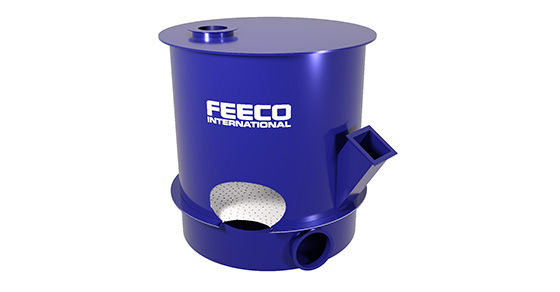Fluid bed dryers are one of the most popular types of industrial dryers, and for good reason: their high rate of heat transfer, paired with their wide applicability and small footprint, makes them favorable in a range of different production settings.
Acquiring a fluid bed dryer that consistently meets both product and process goals, however, can be a challenge. The following looks at the importance of tailoring fluid bed dryer design to the material’s unique characteristics, and how those characteristics influence unit design.
Why Proper Fluid Bed Dryer Design is Essential
While fluid bed dryers are capable of processing a wide array of materials, their success hinges on tailoring the equipment’s design to the specific characteristics of the material being processed.
A fluid bed dryer not designed around feedstock qualities typically results in:
- An inability to meet rated capacity
- Inconsistent product quality and/or product loss
- Frequent process upsets
- Excessive downtime for cleanout
- Unnecessarily high energy consumption
Pretreatment Requirements
As the fluid bed dryer must be designed around the material to be processed, one of the first and most critical aspects of the design process is establishing the feedstock parameters for optimal drying. Unfortunately, material pretreatment requirements are often widely underestimated when it comes to drying, causing many headaches on the production line.
Fluid bed dryers are highly sensitive to fluctuations in feedstock parameters such as moisture content, particle size distribution, shape, etc. Any change in feedstock is likely to result in a process upset, so material going into the fluid bed dryer must be as uniform as possible at all times. Pretreatment requirements may therefore focus on bringing the material characteristics to within optimal drying range, ensuring uniformity in feedstock parameters, or in many cases, both.
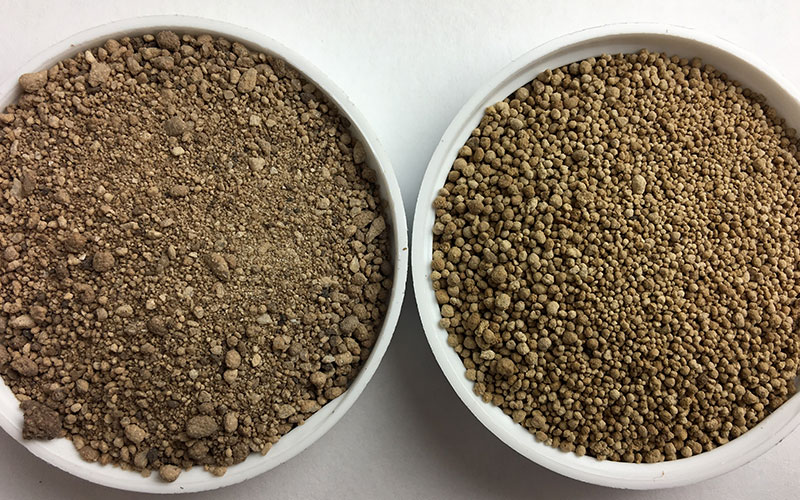
Limestone soil amendment before and after pelletizing. While both samples could be effectively dried in a fluid bed dryer, the sample on the left would experience a significant amount of fines leaving the system. These fines would also likely be overdried (this material could be collected in a baghouse and kept as a separate feedstock for recovery). In contrast, the pelletized lime sample on the right would experience much more uniform, efficient drying, with minimal fines leaving the system.
Pretreatment may consist of size reduction or milling, a pre-drying or back-mixing step, or similar measures. Depending on the material, the need for pretreatment may be obvious at the outset, or may be established through fluid bed dryer testing.
Ultimately, adequate pretreatment sets the drying process up for optimal performance.
Key Material Characteristics
Several material characteristics influence fluid bed dryer design. Most importantly:
Moisture Content
Establishing the difference between the inlet and outlet moisture content sets the stage for how much moisture removal is required, which will in turn have ramifications on retention time, inlet temperature, and pretreatment requirements (if the difference between the inlet and desired outlet moisture content is too great, some sort of dewatering or other moisture reduction pretreatment may be necessary).
Particle Size Distribution (PSD)
Because fluid bed dryers operate on the principle of fluidization, particle size has a significant influence on system design.
Generally, larger particles require a higher air flow velocity to fluidize, though bulk density also factors significantly into this equation.
A wide-ranging particle size distribution makes uniform drying difficult, as larger particles require more velocity to fluidize, which then risks blowing smaller particles out of the system. Here again, this may necessitate pretreatment to encourage more uniformity in particle size.
Particle Shape
Particle shape can also influence dryer design, primarily when it comes to air flow velocity.
Rounded granules, such as a fertilizer product, will behave very differently compared to oblong particles such as a biomass material. The principle concern with particle shape is the potential for particles to interlock, creating mats or clumps of material, which prevents uniform drying and can cause process upsets.
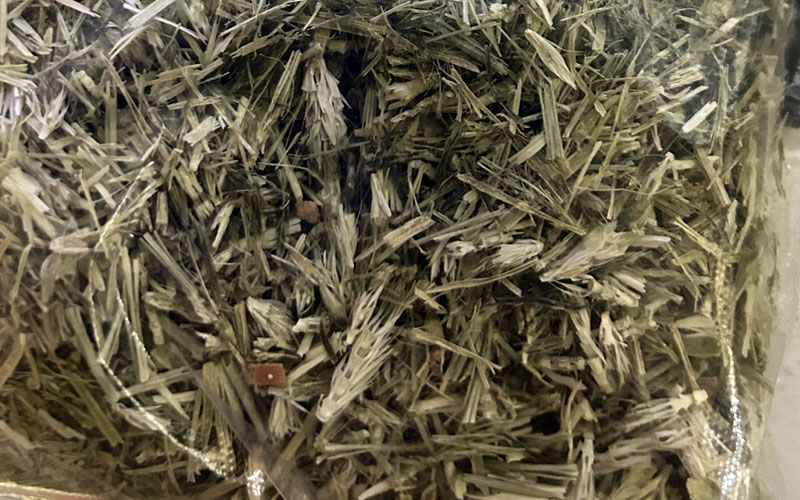
Biomass material such as that shown here may be prone to particles interlocking and creating clumps
As such, velocity may need to be higher to prevent particles from interlocking and clumping together. Alternatively, pretreatment may be utilized to make particles less likely to interlock.
As with the size distribution of particles, the shape must also be as uniform as possible; the more uniform the material going into the dryer, the more uniform the material that will come out.
Bulk Density
As mentioned, bulk density works hand-in-hand with particle size distribution, influencing the amount of velocity required to reach minimum fluidization and the desired fluidization regime.
It’s also important to note that while the primary consideration with bulk density centers around achieving minimum fluidization, bulk density also plays a role in not exceeding the terminal velocity, or the velocity at which the material will be blown out of the system; a fine or lightweight material will require a much lower air velocity to avoid becoming entrained in the air flow and carried out with the exhaust gas.
Specific Heat
Specific heat defines the amount of heat necessary to cause a material’s temperature to rise by one degree. This is an essential consideration in establishing the inlet air temperature, as well as energy requirements for the system. Specific heat also factors into the optimal retention time.
Additional Considerations
While the aforementioned characteristics are the primary influences on dryer design, it’s important to note that other qualities can also influence the design process.
Fragility
Fragility, or how prone to degradation a material is, may necessitate gentle fluidization to minimize attrition.
Chemical Composition
A material’s chemical composition may present any number of challenges. This might include becoming tacky at certain temperatures, a sensitivity to heat, or otherwise.
Key Aspects of Design
Engineers work from these characteristics, in combination with the desired throughput, to establish key process criteria:
Inlet Air Temperature
The inlet air temperature is determined by the maximum allowable temperature the material can handle. Depending on how sensitive the material is to heat, this may range anywhere from 300°F to 1500°F. It may also be influenced by how the material carries its moisture – on the surface or internally.
Air Flow Velocity (and Fluidization Regime)
The velocity at which the drying air flows through the fluid bed dryer is one of the most influential aspects of the drying process. And while this is true for most types of industrial dryers, it is especially true when it comes to fluid beds, as the velocity also determines the level of fluidization the material experiences, or rather, the fluidization regime.
Fluidization occurs between the minimum fluidization velocity, or the point at which the material starts to suspend, and terminal velocity, or the point at which the material is simply carried out of the system in the air stream.
In combination with material characteristics such as bulk density, particle size distribution, and more, the velocity determines the fluidization regime, or material flow pattern. Between minimum fluidization and terminal velocity, several regimes exist. Each regime becomes increasingly turbulent with a less clearly defined (or more “dilute”) material bed, ultimately moving toward pneumatic conveying.
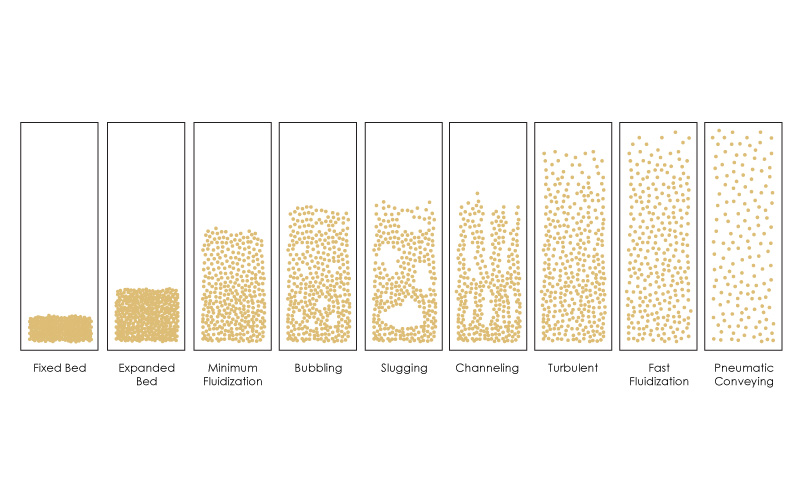
Illustration of fluidization regimes
Therefore, the velocity determines both the amount of heat transfer occurring in the dryer, as well as the amount of particle collision and subsequent attrition.
Retention Time
Retention or residence time refers to the time the material must remain in the vessel to reach the desired outlet moisture.
Retention time is controlled by balancing air flow velocity with weir height. A weir is an adjustable plate that blocks the discharge chute so the material bed must reach a predetermined height (and therefore retention time) before it is discharged from the unit.
The Fluid Bed Dryer Design Process
As with any type of industrial dryer, the process of designing a fluid bed dryer relies on careful engineering to balance material characteristics with the desired outcome.
This starts by analyzing a representative feedstock sample. Unless the drying process is already well established, this typically begins with test work in a facility such as the FEECO Innovation Center.
Here, process experts can confirm the feasibility of drying the intended material, as well as work out basic process criteria, including the need for any pretreatment.
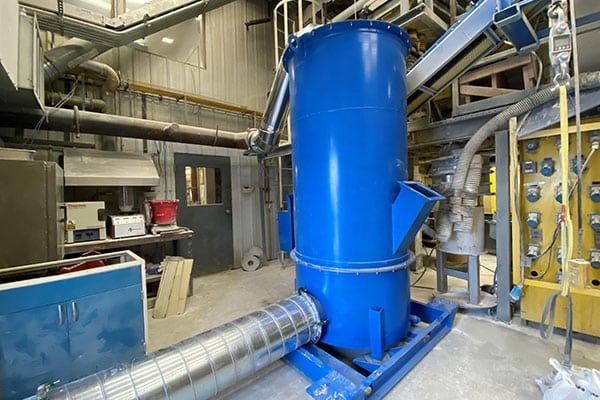
Pilot-scale fluid bed dryer used for testing in the FEECO Innovation Center
A variety of data is gathered during testing, including:
- Inlet and outlet temperature
- Velocity
- System pressures
- Bed distributor plate configuration
- Percent fill
- Feed and product flow rates
- Retention time
This data is then used to design a commercial-scale dryer.
Conclusion
Fluid bed dryers offer efficiency and versatility in industrial drying applications, but their success lies in meticulous design tailored to the specific material being processed. By accounting for material characteristics such as moisture content, particle size distribution, and bulk density, engineers can ensure optimal performance and product quality. Pretreatment steps and thorough testing during the design process further help to mitigate risks and achieve process stability.
A leader in thermal processing since 1951, FEECO fluid bed dryers are backed by decades of drying expertise around hundreds of materials. Combined with our extensive testing capabilities, our custom fluid bed dryers are engineered around your process and material goals for a solution that operates reliably and is built for longevity. For more information on our fluid bed dryers or pilot plant, contact us today!
Have questions about fluid bed dryers? Check out our FAQs!

